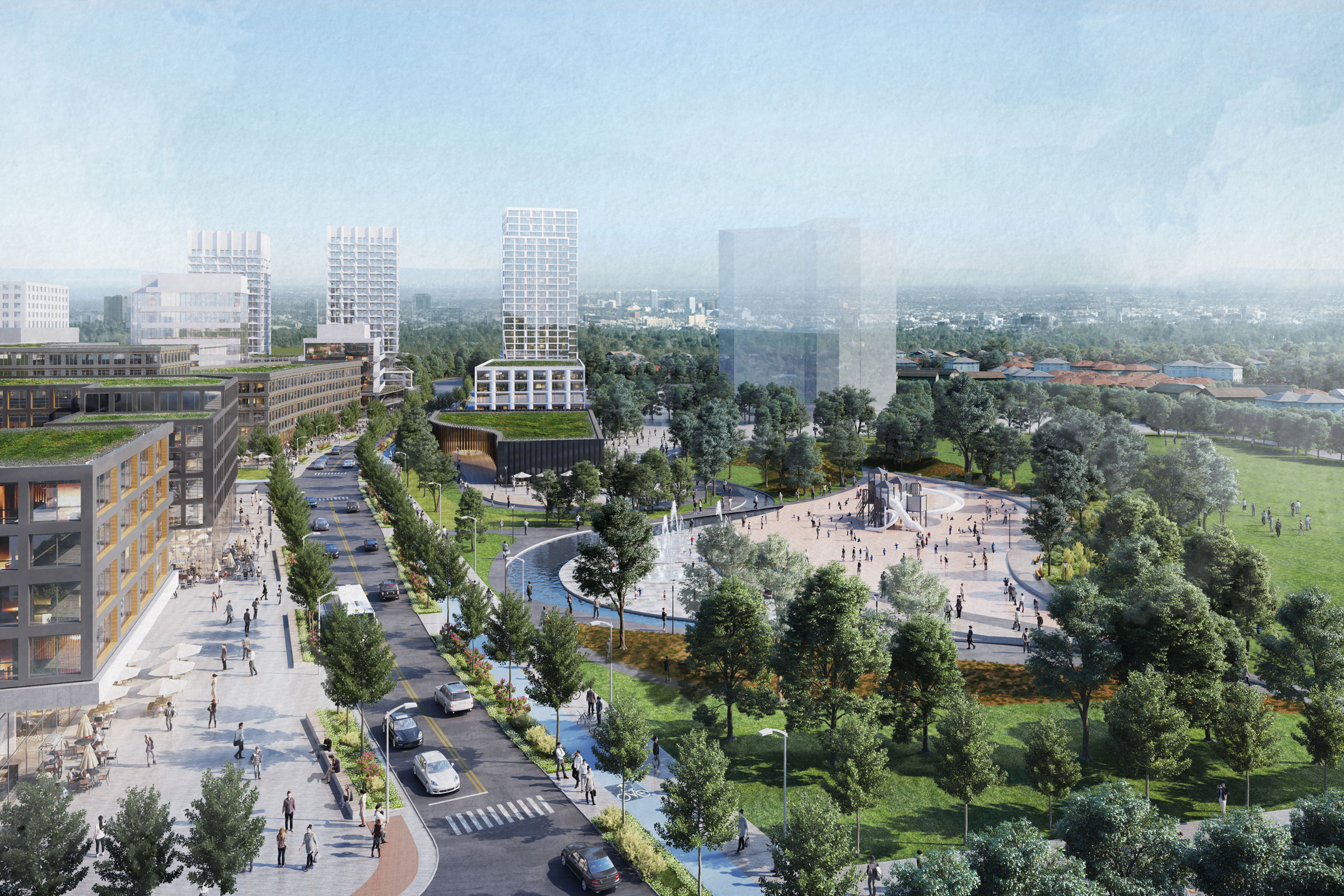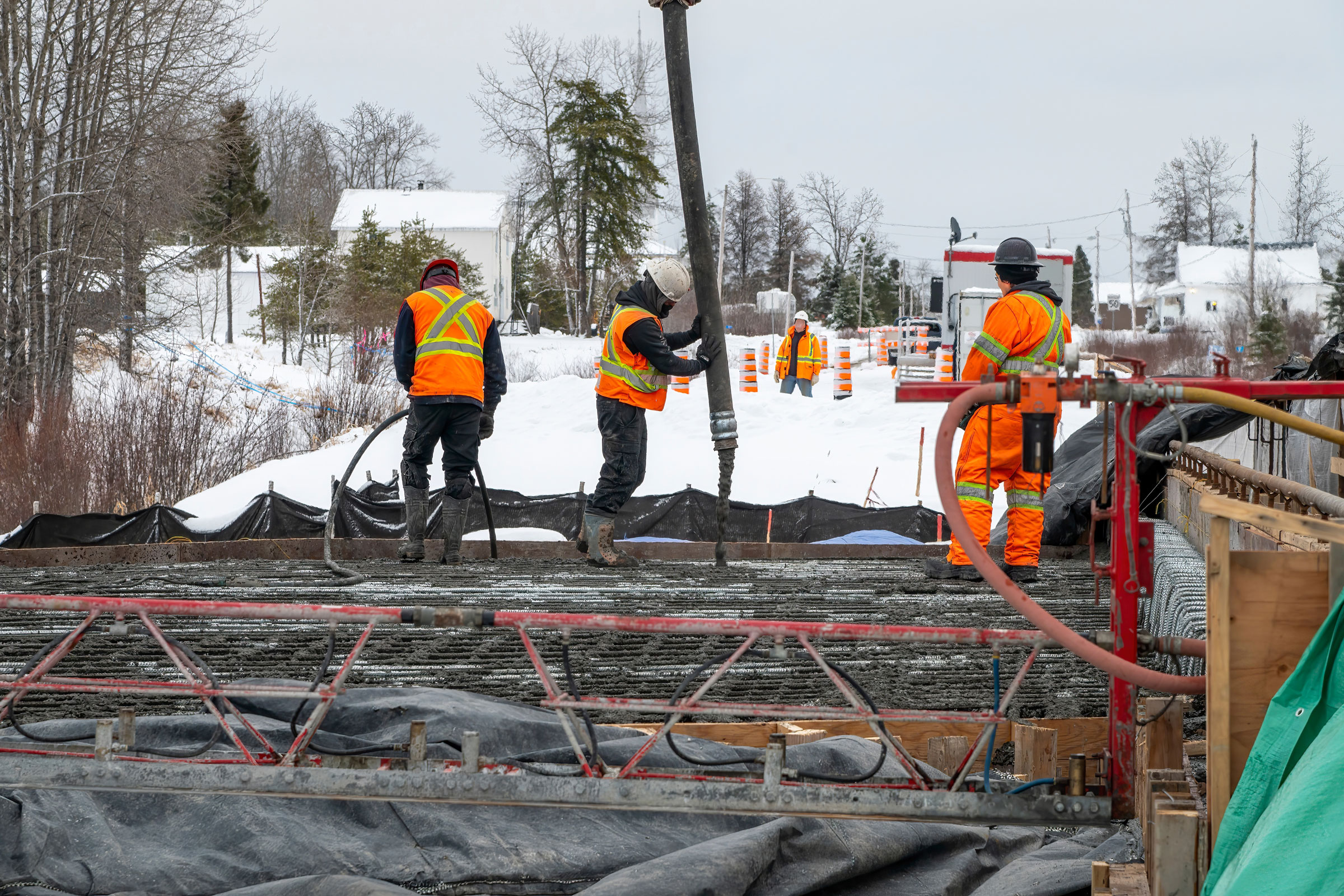Story at a glance:
- Toronto-based SvN Architects + Planners are tasked with making a car-dominant place more walkable.
- The Shoppers World Brampton revitalization was an opportunity to support a shift in urban thinking for the city as a whole.
- The design team aimed to develop a resilient landscape design that peeled away the asphalt and reset the land as part of the original watersheds.
Shoppers World Brampton is in Brampton’s “uptown core,” a rapidly growing, ethnically diverse, and demographically young suburban municipality of 650,000 people northwest of Toronto. In the early 1960s, Shoppers World emerged from a farmer’s field into a regional shopping destination. Today Shoppers World is the main retail destination for the city, consisting of more than 140 stores and 3,000 parking spots.
As a car-dominant city, Brampton is currently experiencing a period of rapid population growth with numerous public and private investments being made to transform the suburban experience of Brampton into a more walkable and urban metropolis. Specifically, the City of Brampton identified growth around the 53-acre Shoppers World site, which necessitated the construction of the 18-kilometer Hurontario LRT. The new LRT will travel from its northernmost terminus at the Shoppers World site southward to Lake Ontario at Port Credit, another significant regional urban node.
As a result, the Shoppers World Brampton revitalization presented an opportunity to create a defining gateway for the new LRT Terminal and support a shift in urban thinking for the city as a whole. The strategy needed to transform this 50-year-old shopping plaza and massive parking lot into a walkable, connected urban mixed-use neighborhood and central hub.
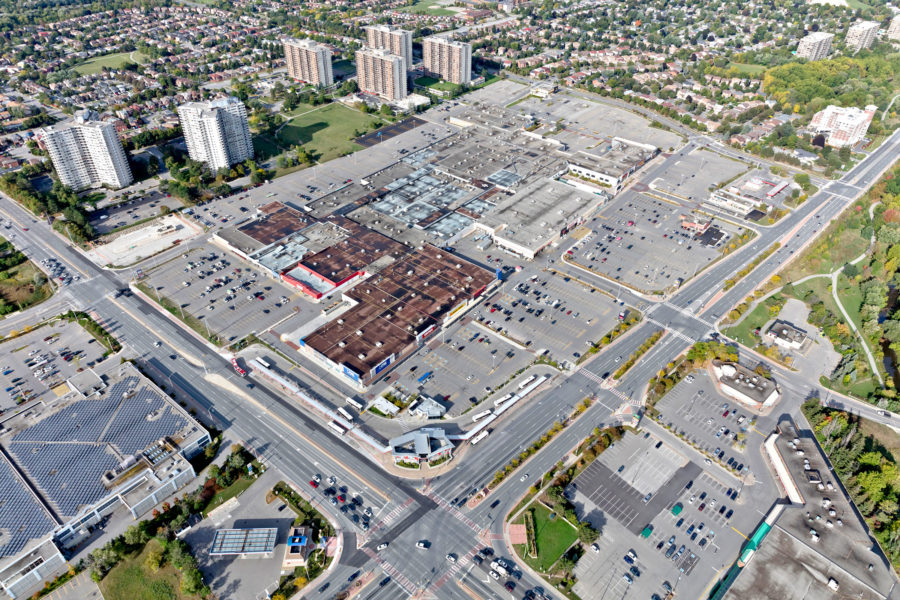
Today Shoppers World is a one-story regional mall with anchor tenants. Sited in the middle of a mega-block and ringed with surface parking, it is located adjacent to two, eight-lane arterial roads. One would never know this was a once-verdant landscape, set within the Oak Ridges Moraine—a precious watershed divide between Lake Ontario and Lake Simcoe. Photo courtesy of SkyGuys
In collaboration with our client, RioCan Real Estate Investment Trust, we at SvN Architects + Planners recognized the project would benefit from expanding the design team to plan a new urban vision for the adaptive reuse of the site. In 2019 RioCan invited BDP Quadrangle to work with us to develop a master plan that would form the basis for securing redevelopment site entitlements to transform Shoppers World into a mixed-use, transit-oriented community. Our focus was also to develop a resilient landscape design that peels away the asphalt and resets the land as part of the original watersheds that existed for millennia.
Landscape Strategy: Reconnecting with the Surrounding Ecology
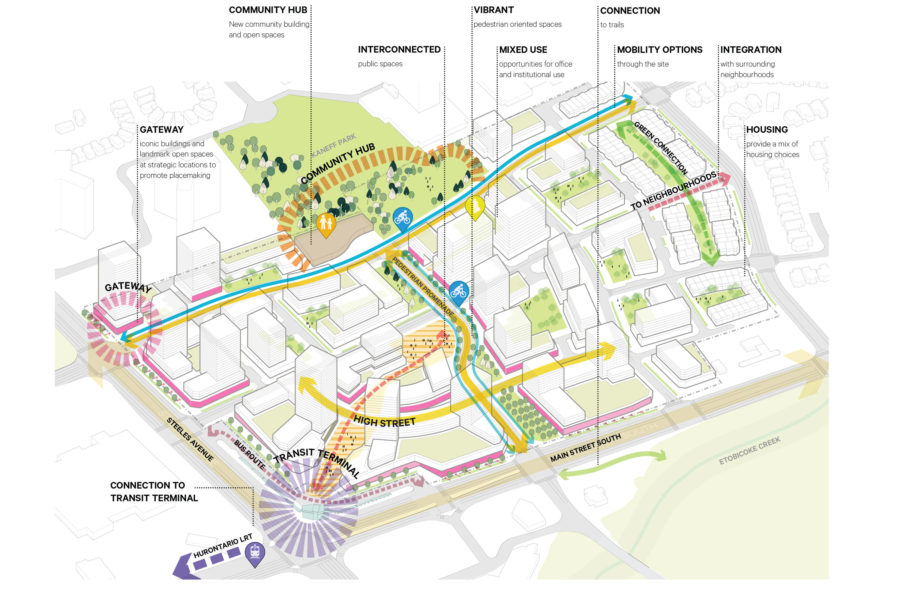
The new street and block framework that underpins the development re-establishes connections between natural systems and open spaces, and assures direct, legible, and enjoyable paths of travel between the transit hub and each new district. Image courtesy of BDP Quadrangle and SvN Architects + Planners
The Hurontario LRT’s strong north-south physical connection positions Shoppers World at the interchange of multiple higher-order transit lines, including GO Transit’s Milton and Lakeshore West lines. However, the site’s unique location at the confluence of the Etobicoke and Fletchers creeks, which stem from the Oak Ridges Moraine, initiated considerable attention to the redevelopment’s landscape and urban sustainability strategies. The Oak Ridges Moraine contains the headwaters to more than 30 rivers and tributaries that lead out to Lake Ontario. The combination of these two characteristics—transit and landscape—created the foundation for the site’s new narrative.
Together the project team developed a master plan that ensures urban design continuity through a site-wide landscape narrative, creating unique design opportunities within each phase of development. Collaboratively, we established a seamless interface between programmatic elements and built form to ensure distinctive moments within each district. Woven throughout the community are a series of courtyards, pocket parks, green roofs, terraces, and an urban bosque where people can gather for markets and pop-up events.
Focusing on a landscape-first design strategy that is inspired by the history of the site as farmer’s field, as well as the surrounding natural ecology, allows us to celebrate the site’s genuine landscape identity and helped build consensus within the community. This strategy also provided assurance that a consistent vision can be maintained during the 20-year cycle of the site’s redevelopment. The landscape would be common thread that will tie all the different pieces of the built environment together.
Following a two-year design and community engagement process that included regional and municipal authorities and the general public, the master plan and proposed planning amendments to enable site redevelopment received unanimous approval by Brampton City Council in 2020.
Transforming Gray to Green: Challenges to Overcome
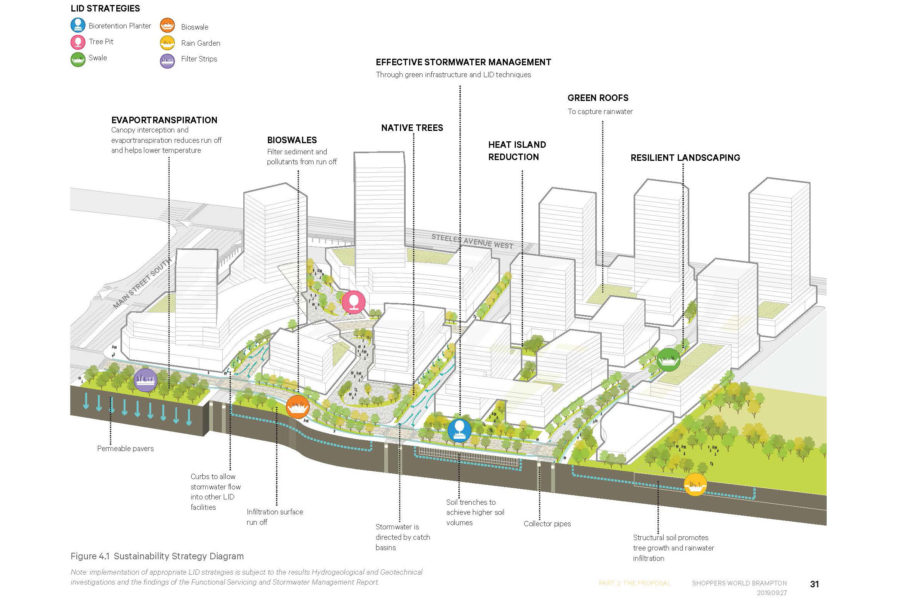
Low impact development strategies such as permeable pavers, infiltration surfaces, and soil trenches were integrated into early stages of streetscape planning and design. Image courtesy of BDP Quadrangle and SvN Architects + Planners
Developing such a master plan from concept to implementation comes with many challenges. Moving from schematic to detail design with subsequent approval processes along the way requires a vision that needs to be supported by officials who can appreciate how our proposed plans may not comply with existing—and often outdated—municipal standards.
The critical issue was transitioning the site’s extensive impervious hard surfaces with little to no stormwater management into a more porous site. The key to achieving this goal was gaining support from municipal authorities at the earliest planning stages to help facilitate the integration of stormwater management systems in areas conveyed as publicly held assets. Beyond block-level controls within buildings, our team designed the integration of stormwater infrastructure systems within public and private streetscaping, rooftop spaces, and open space.
Other initiatives include low-impact development techniques comprising bio-retention planters, rain gardens, swales, bioswales, permeable pavers, and filter strips incorporated into public and private parks and streetscapes. These concepts still need to be realized at Shoppers World. Still, we believe integrating them within the master plan and other site-specific performance standards will bolster typical green standards applicable to the site while solidifying the consensus reached with municipal approval authorities, including the Buildings and Permits Department.
Transforming Old Retail Typologies into Modern Mixed-Use Communities
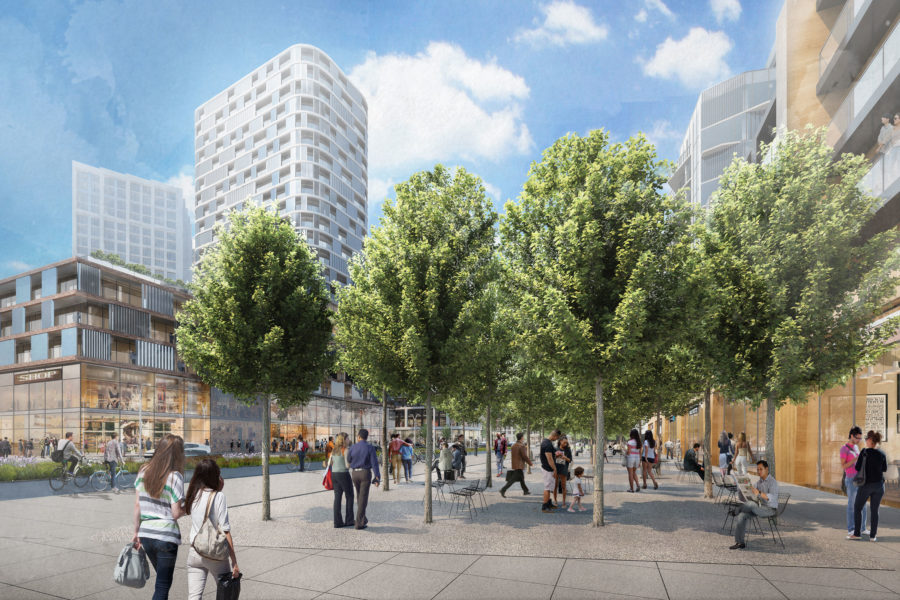
A reimagined Shoppers World in Brampton will emerge as an exemplary suburban shopping center renewal project through a regenerative design that provides places for respite and public activity within a dynamic commercial hub. Rendering courtesy of BDP Quadrangle and SvN Architects + Planners
The streets that led into Shoppers World and the roadways designed within the site reprioritize the importance of front of house spaces that face onto them, thereby giving prominence to storefronts, entryways, pocket parks, and other landscape architecture features that define our cities—that define successful placemaking.
A series of new streets and open-space designs are inspired by the surrounding river and creek ecology. The master plan proposes a wooded landscape, or bosque, marking the east gateway to Shoppers World. The bosque establishes a visual contrast to the adjacent regional road and sound buffer from the relentless noise of speeding vehicles. It will also provide immediate respite to those who work in and visit the site when they cross the threshold into Shoppers World.
The bosque also serves as a practical wooded framing of a new pedestrian-focused promenade augmented on one side by a continuous linear park. Its dual purpose is to re-stitch the Etobicoke Creek on the east and Fletcher’s Creek on the west through an interconnected bio-system.
Brampton is a city within the Greater Toronto Area, a region projected to see its population increase by 2.9 million, from 7.1 million in 2020 to almost 10 million by 2046. As stewards of our land assets, we must design our cities to access housing, services, and amenities reliant on public transit. We cannot afford to keep adding thousands of new cars on our streets every year, a vicious cycle that only diminishes the potential of our existing streetscapes to evolve into increasingly meaningful and safe public spaces. Shoppers World Brampton is a great example of how a landscape-first approach can work to support economic growth, social cohesion, and ecological resiliency.

